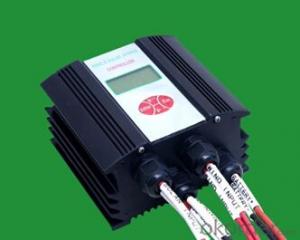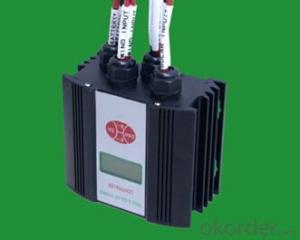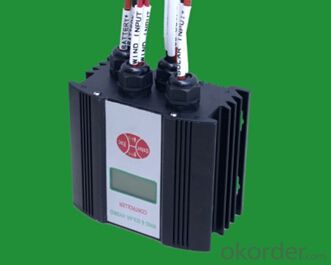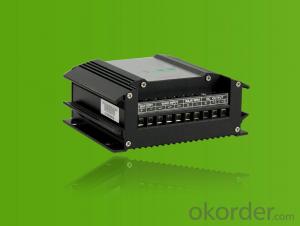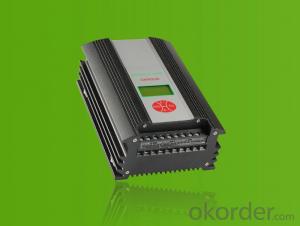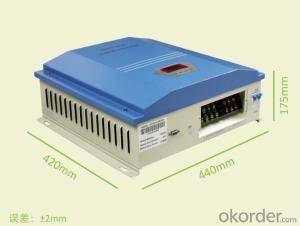Solar Charge Controllers Waterproof Wind Solar Hybrid Street Light Controller
- Loading Port:
- Shanghai
- Payment Terms:
- TT or LC
- Min Order Qty:
- 1 unit
- Supply Capability:
- 5000 unit/month
OKorder Service Pledge
OKorder Financial Service
You Might Also Like
I. PRODUCT INTRODUCTION
The wind/solar hybrid controller is specially designed for high-end small-scale wind/solar hybrid system and especially suitable for wind/solar hybrid street light system and wind/solar hybrid monitoring system.The controller can control wind turbine and solar panel at the same time and transform the wind and solar energy into electricity for DC load use, with excess energy stored into batteries. Varieties of appearance and function design, which is flexible to meet the requirements of different customers.
II. 12V TECHNICAL PARAMETERS
Product Model | WWS02-12-N00D | WWS03-12-N00D | WWS04-12-N00D |
Rated battery voltage | 12V | 12V | 12V |
Rated wind turbine input voltage | 200W | 300W | 400W |
Maximum wind turbine input power | 300W | 450W | 600W |
Wind Turbine Brake Current | 20A | 30A | 40A |
Rated Solar Input Power | 150W | ||
Dumpload Start Voltage | 13.5V | ||
Complete discharge voltage | 14.5V | ||
Battery Under Voltage Shutoff | 10.8V | ||
Battery Under Voltage recovery | 12V | ||
Input over voltage shutoff | 16V | ||
Light Control On Voltage | 1V | ||
Light Control Off Voltage | 1.5V | ||
Rated Output Current of Load 1 and Load 2 | 10A | ||
Load 1 Output Control Mode | Light Control On and Light Control Off | ||
Load 2 Output Control Mode | Light Control On and Time Control 5 Hours Off | ||
Dumpload Control Mode | PWM | ||
Display Mode | LCD | ||
Cooling | Aluminium alloy shell radiating | ||
Protection Level | IP53(Indoor) | ||
Quiescent Current | ≤20 mA | ||
Display Content | Battery Voltage, Wind Turbine Voltage, PV Voltage, Wind Turbine Current, PV Current, Wind Turbine Power, PV Power, Over Voltage, Under Voltage, Over Load, Short Circuit, Night etc status | ||
Protection Functions | Solar reverse charge protection , Solar reverse connection protection, Battery over charge protection, Battery over discharge protection, Battery reverse connection protection, Over load protection, Short circuit protection, Lightning protection Wind turbine current limiting, Wind turbine automatic brake and manual brake. | ||
Ambient temperature | -20~+55℃ | ||
Ambient Humidity | 0~93%, without condensing | ||
Working Altitude | ≤4000m | ||
Dimension | 144×152×82mm | ||
Net weight | 1.9kg | ||
III. 24V TECHNICAL PARAMETERS
Product Model | WWS03-24-N00D | WWS04-24-N00D | WWS06-24-N00D |
Rated battery voltage | 24V | 24V | 24V |
Rated wind turbine input power | 300W | 400W | 600W |
Maximum wind turbine input power | 450W | 600W | 900W |
Rated solar input power | 300W | 300W | 300W |
Dumpload Start Voltage | 27V | 27V | 27V |
Charge Shutoff Voltage | 29V | 29V | 29V |
Wind Turbine Brake Current | 15A | 20A | 30A |
Battery Under Voltage Shutoff | 21.6V | ||
Battery Under Voltage Recovery | 24V | ||
Input Over Voltage Shutoff | 32V | ||
Light Control On Voltage | 2V | ||
Light Control Off Voltage | 3V | ||
Rated Output Current of Load 1 and Load 2 | 10A | ||
Load 1 Output Control Mode | Light Control On and Light Control Off | ||
Load 2 Output Control Mode | Light Control On and Time Control 5 Hours Off | ||
Dumpload Control Mode | PWM | ||
Display Mode | LCD | ||
Protection Level | IP53(Indoor) | ||
Quiescent Current | ≤20mA | ||
Display Content | Battery Voltage, Wind Turbine Voltage, PV Voltage, Wind Turbine Current, PV Current, Wind Turbine Power, PV Power, Over Voltage, Under Voltage, Over Load, Short Circuit, Night etc status | ||
Protection Functions | Solar reverse charge protection , Solar reverse connection protection, Battery over charge protection, Battery over discharge protection, Battery reverse connection protection, Over load protection, Short circuit protection, Lightning protection Wind turbine current limiting, Wind turbine automatic brake and manual brake. | ||
Ambient Temperature | -20~+55℃ | ||
Ambient Humidity | 0~93%, without condensing | ||
Working Altitude | ≤4000m | ||
Dimension (L x W x H) | 144×152×82mm | ||
Net Weight | 1.9kg | ||
- Q: Can a solar controller be used with a solar-powered beekeeping system?
- Yes, a solar controller can be used with a solar-powered beekeeping system. A solar controller is designed to regulate and optimize the charging and discharging of batteries in a solar system. In a solar-powered beekeeping system, the solar controller would ensure that the batteries storing the solar energy are charged efficiently and that the power is distributed appropriately to power the various components of the beekeeping system, such as pumps, heaters, or lights.
- Q: Can a solar controller be used with a solar-powered billboard?
- Yes, a solar controller can be used with a solar-powered billboard. A solar controller helps regulate and optimize the charging process of the batteries connected to the solar panel. In the case of a solar-powered billboard, the solar controller ensures that the solar panel efficiently charges the batteries during daylight hours, and then controls the power flow to the billboard during nighttime or periods of low sunlight. By using a solar controller, the solar-powered billboard can effectively utilize the solar energy and maintain a consistent power supply.
- Q: What is the maximum load power a solar controller can handle?
- The maximum load power a solar controller can handle depends on its specific specifications and capabilities. It varies from controller to controller and can range anywhere from a few hundred watts to several kilowatts. It is essential to consult the manufacturer's specifications or product documentation to determine the specific maximum load power capacity of a particular solar controller.
- Q: How does a solar controller monitor the battery voltage?
- A solar controller monitors the battery voltage by continuously measuring the voltage level of the battery. It uses built-in sensors and circuitry to accurately measure the voltage and then adjusts the charging and discharging processes accordingly to maintain the battery within safe voltage limits.
- Q: How do I protect a solar controller from overheating?
- There are several precautions you can take to safeguard your solar controller from overheating: 1. Optimal installation: It is crucial to mount the solar controller in a well-ventilated area, away from direct sunlight and other heat sources. This will prevent excessive heat buildup. 2. Proper sizing: Ensure that the solar controller is appropriately sized for your solar panel system. Undersized controllers may struggle to handle the load, leading to overheating. Consult the manufacturer's specifications or seek professional advice to ensure compatibility. 3. Monitor ambient temperature: Regularly check the surrounding temperature near the solar controller. If it exceeds the recommended operating range, consider relocating the controller to a cooler area or enhancing ventilation. 4. Utilize heat sinks: If the solar controller is placed in a confined or enclosed space, consider using heat sinks or devices that dissipate heat. These will absorb and disperse excess heat, preventing damage to the controller. 5. Install thermal sensors: Advanced solar controllers often come equipped with built-in thermal sensors that can detect excessive heat and automatically shut down or reduce the load on the controller. If your controller lacks this feature, consider installing external thermal sensors to monitor and trigger protective measures. 6. Ensure proper wiring: Faulty or loose wiring can increase resistance and cause the solar controller to overheat. Regularly inspect the wiring connections to ensure they are secure, tight, and properly insulated. Address any signs of damage or overheating promptly. 7. Regular maintenance: Periodically clean and inspect the solar controller for debris, dust, or dirt accumulation, as these can hinder proper heat dissipation. Gently clean the controller using a soft brush or compressed air. By following these steps, you can safeguard your solar controller from overheating, ensuring optimal performance and longevity.
- Q: Can a solar controller be used with solar battery storage systems?
- Yes, a solar controller can be used with solar battery storage systems. A solar controller, also known as a charge controller, is designed to regulate the amount of charge going into the batteries to prevent overcharging and extend their lifespan. It ensures that the solar panels are charging the batteries efficiently and effectively. Therefore, when using a solar battery storage system, a solar controller is an essential component to ensure the proper charging and maintenance of the batteries.
- Q: Can a solar controller be used with a solar-powered drone?
- Yes, a solar controller can be used with a solar-powered drone. A solar controller is responsible for regulating the power flow between the solar panels and the drone's battery, ensuring efficient charging and preventing overcharging. It helps optimize the use of solar energy and ensures the drone operates smoothly and reliably.
- Q: Can a solar controller be used with a solar-powered gym or fitness center?
- Yes, a solar controller can be used with a solar-powered gym or fitness center. A solar controller is designed to regulate and optimize the charging process of solar panels, ensuring efficient power generation and preventing overcharging of batteries. It can be used in conjunction with a solar-powered system to manage and control the flow of solar energy, allowing the gym or fitness center to operate on clean and sustainable power.
- Q: What is the role of a solar controller in maintaining battery health?
- The significance of a solar controller in preserving battery health cannot be overstated. It functions as both a regulator and guardian for the battery that is connected to a solar power system. Its primary responsibility is to ensure that the battery is charged and discharged correctly, thereby averting the detrimental effects of overcharging and deep discharging on the battery's longevity and overall well-being. One of the principal tasks of a solar controller is to oversee and manage the battery's charging process. It accomplishes this by controlling the flow of current from the solar panels to the battery, guaranteeing that the battery receives an appropriate charge that aligns with its capacity and state of charge. Through its regulation of the charging process, the solar controller effectively prevents overcharging, which can inflict harm upon the battery, such as diminished capacity or even irreversible failure. In addition, the solar controller performs an integral role in safeguarding the battery against deep discharging. Exceeding a certain level of discharge can result in irreparable damage and a reduced lifespan for the battery. By constantly monitoring the battery's voltage, the solar controller intervenes and disconnects the load from the battery once it reaches a predetermined low voltage threshold. This preventative measure effectively averts deep discharging and ensures that the battery remains within safe operational parameters. Moreover, a solar controller often incorporates various protective mechanisms to shield the battery from potential issues. These protective features can include safeguards such as short-circuit protection, reverse polarity protection, and temperature compensation. By implementing these protective measures, the solar controller prevents any inadvertent damage to the battery caused by external factors or improper installation. In conclusion, the primary role of a solar controller in maintaining battery health is to regulate and safeguard the battery throughout the charging and discharging process. Through the prevention of overcharging and deep discharging, as well as the inclusion of additional protective mechanisms, the solar controller contributes to the prolonged lifespan, optimized performance, and overall well-being of the battery within a solar power system.
- Q: How does a solar controller prevent damage to solar panels?
- A solar controller prevents damage to solar panels by regulating the amount of voltage and current flowing from the solar panels to the batteries or load. It ensures that the output is within safe limits, preventing overcharging, over-discharging, and voltage fluctuations that can harm the panels and reduce their lifespan.
Send your message to us
Solar Charge Controllers Waterproof Wind Solar Hybrid Street Light Controller
- Loading Port:
- Shanghai
- Payment Terms:
- TT or LC
- Min Order Qty:
- 1 unit
- Supply Capability:
- 5000 unit/month
OKorder Service Pledge
OKorder Financial Service
Similar products
Hot products
Hot Searches
Related keywords
